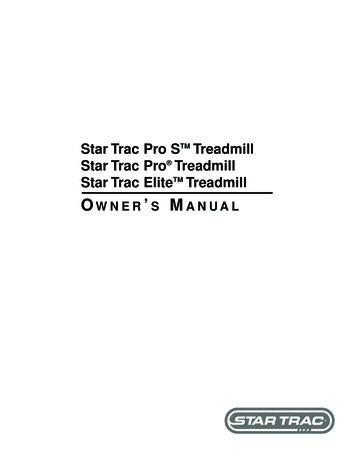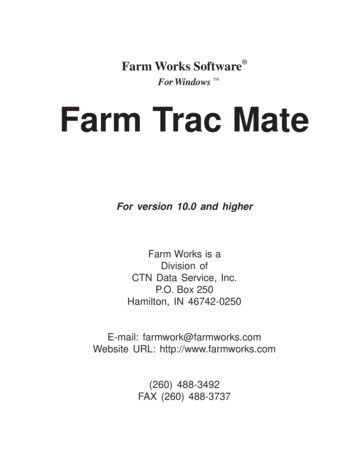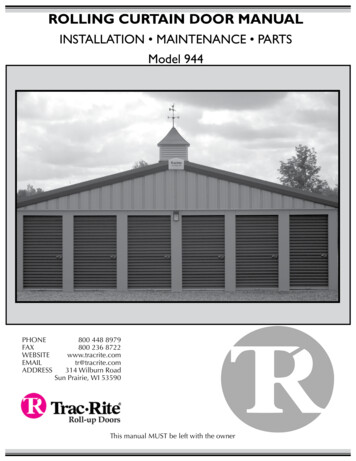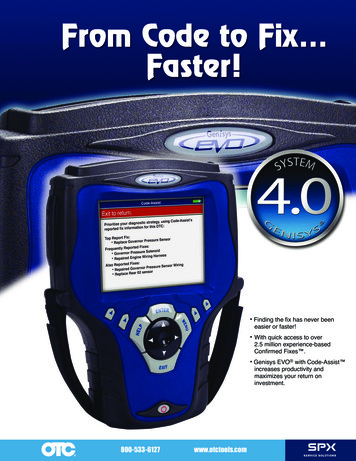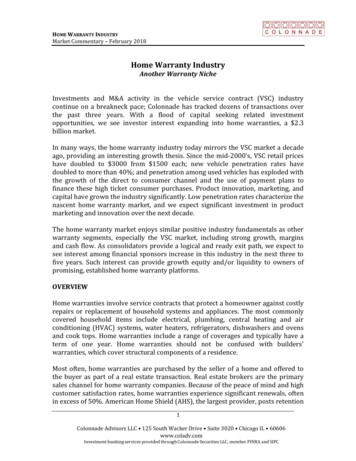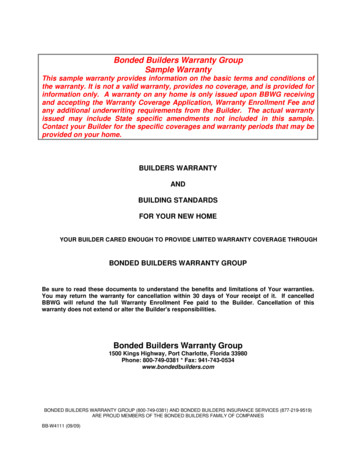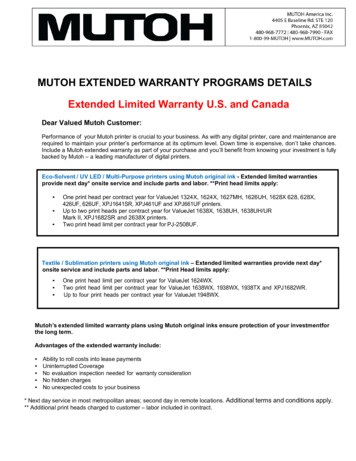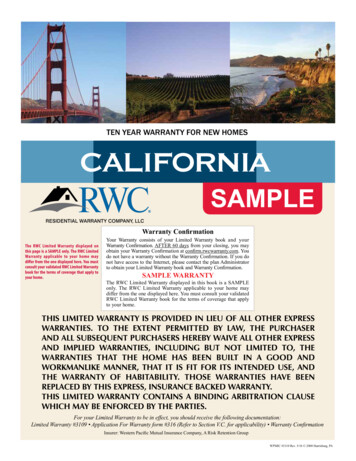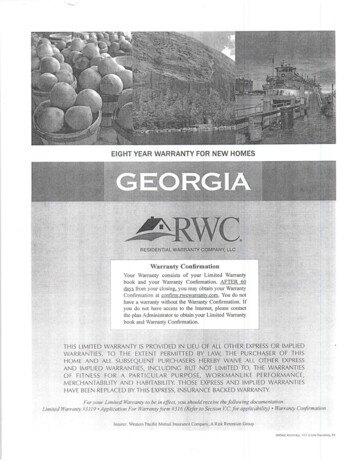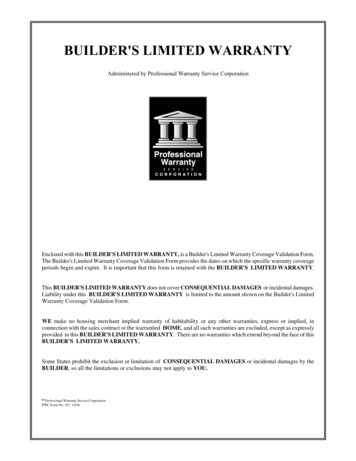
Transcription
WarrantyYour new Sure-Trac trailer is warranted by Novae Corp. to be free from defects in material or workmanship for 3 years,with reasonable limitations.Additional Warranties 1 Year Tire Hazard and Abuse Protection: All tires provided with Sure-Trac trailers come with hazard and abuseprotection for 1 year, starting on your purchase date. Should you encounter any issue with your tire, including roadhazard damage, blowout, flat tire etc. our tire supplier will, without question, replace the tire at no charge, freight paid tothe dealer or owner along with a preset installation labor reimbursement. 5 Year Standard Tire Warranty: All tires are covered under the original manufacturer’s 5 year limited warranty againstdefects in material and workmanship. See www.sure-trac.com for tire warranty details. 5 Year Axle and Suspension Warranty: Sure-Trac provides only premium axles that are warranted by themanufacturer for 5 years for leaf spring and 10 years for torsion axles. See www.sure-trac.com for axle warrantydetails. 1 Year Hydraulic Pump and Cylinder Warranty: Sure-Trac provides hydraulic pumps and cylinders warranted by theoriginal manufacturer for 1 year from your purchase date. See www.sure-trac.com for hydraulic component warrantydetails.To Obtain ServiceContact an authorized Sure-Trac dealer to open a warranty claim. Your dealer will contact Novae Corp. to obtain authorizationprior to any work being done. Novae Corp. will service all claims but will not accept liability for repairs made without approval.RegistrationYour trailer must be registered to validate your purchase date and process any warranty request. You may register at anytime, however, if we cannot validate your purchase date, your warranty period will commence on the date of manufacture.Warranty registration is available through your dealer or on the web at www.sure-trac.com. Another benefit of timelyregistration is to be sure you receive safety and other notices.LimitationsItems NOT Covered Under This Warranty:1. Maintenance items worn through normal use like bearings, brakes, tires, lumber, batteries, etc.2. Hydraulic pumps and cylinders, axles and suspensions, wheels and tires covered under the original manufacturer’swarranty. See additional warranties above and www.sure-trac.com for details.3. Paint.4. Damage or failure resulting from: a) any misuse including, overloading, improper loading, negligence, alteration, oraccidents, b) inadequate maintenance including loose nuts, bolts, screws, or improperly torqued wheel lug nuts, c)use of underrated or incorrect hitch equipment including the hitch ball, pintle, or improper hitching, d) towing a trailerthat exceeds the tow vehicle manufacturer’s specific towing limitations.5. Inconvenience, loss of time, loss of trailer use, loss of revenue, rental or substitute equipment costs or any other lossor cost including travel time and expenses, such as food, fuel, lodging, etc., incurred to obtain warranty service.6. Overtime labor rates, service calls, towing charges, expediting, freight or transportation costs.Limitation of RemediesUNDER NO CIRCUMSTANCES WILL NOVAE CORP. BE LIABLE TO A PURCHASER OR ANY OTHER PERSON FOR ANY SPECIAL,INCIDENTAL, INDIRECT, CONSEQUENTIAL, OR PUNITIVE DAMAGES ARISING OUT OF OR RELATING TO THE SALE OF GOODS BYNOVAE CORP., WHETHER UNDER A THEORY OF CONTRACT, NEGLIGENCE, STRICT LIABILITY OR OTHERWISE. THE OBLIGATIONOF NOVAE CORP. UNDER THIS WARRANTY IS LIMITED TO REPAIR OR REPLACEMENT OF ANY PART OR PARTS WHICH, IN THEOPINION OF NOVAE CORP. IS/ARE DEFECTIVE IN MATERIAL OR WORKMANSHIP UNDER NORMAL USE AND SERVICE. IN NOEVENT WILL NOVAE CORP.’S TOTAL LIABILITY TO A PURCHASER UNDER THIS LIMITED WARRANTY EXCEED THE PURCHASEPRICE OF THE PRODUCT(S).DisclaimersTHIS LIMITED WARRANTY IS IN LIEU OF ALL OTHER WARRANTIES, EXPRESSED OR IMPLIED,INCLUDING ANY IMPLIEDWARRANTY OF MERCHANTABILITY, WARRANTY OF FITNESS FOR A PARTICULAR PURPOSE, OR ANY IMPLIED WARRANTIESARISING FROM COURSE OF PERFORMANCE, COURSE OF DEALING OR USAGE OF TRADE, ALL OF WHICH ARE EXPRESSLYDISCLAIMED. THERE ARE NO OTHER WARRANTIES, AGREEMENTS OR UNDERSTANDING WHICH EXTEND BEYOND THOSE SETFORTH IN THIS DOCUMENT. NO OTHER WARRANTY, ORAL OR WRITTEN, IS AUTHORIZED OR HAS BEEN GIVEN BY NOVAE CORP.TO PURCHASER. THIS WARRANTY IS EXTENDED TO THE ORIGINAL REGISTERED OR CONSUMER OWNER AND IS NOTTRANSFERABLE.
Tire Safety: Everything Rides On ItThe National Traffic Safety Administration (NHTSA) has published abrochure (DOT HS 809 361) that discusses all aspects of Tire safety, asrequired by CFR 575.6. This brochure is reproduced in part below. It canbe obtained and downloaded from NHTSA, free of charge, from thefollowing web desonit/tires index.htmlStudies of tire safety show that maintaining proper tire pressure, observingtire and vehicle load limits (not carrying more weight in your vehicle thanyour tires or vehicle can safely handle), avoiding road hazards, andinspecting tires for cuts, slashes, and other irregularities are the mostimportant things you can do to avoid tire failure, such as tread separationor blowout and flat tires. These actions, along with other care andmaintenance activities, can also: Improve vehicle handling Help protect you and others from avoidable breakdowns and accidents Improve fuel economy Increase the life of your tiresThe following information presents a comprehensive overview of tiresafety, including information on the following topics: Basic tire maintenanceUniform Tire Quality Grading SystemFundamental characteristics of tiresTire safety tipsUse this information to make tire safety a regular part of your vehiclemaintenance routine. Recognize that the time you spend is minimalcompared with the inconvenience and safety consequences of a flat tire orother tire failure.Safety First–Basic Tire MaintenanceProperly maintained tires improve the steering, stopping, traction, and loadcarrying capability of your vehicle. Underinflated tires and overloadedvehicles are a major cause of tire failure. Therefore, as mentioned above, toavoid flat tires and other types of tire failure, you should maintain propertire pressure, observe tire and vehicle load limits, avoid road hazards, andregularly inspect your tires.Finding Your Vehicle's Recommended TirePressure and Load LimitsTire information placards and vehicle certification labels containinformation on tires and load limits. These labels indicate the vehiclemanufacturer's information including: Recommended tire size Recommended tire inflation pressure Vehicle capacity weight (VCW–the maximum occupant and cargoweight a vehicle is designed to carry) Front and rear gross axle weight ratings (GAWR– the maximum weightthe axle systems are designed to carry).Both placards and certification labels are permanently attached to the trailernear the left front.Understanding Tire Pressure and Load LimitsTire inflation pressure is the level of air in the tire that provides it withload-carrying capacity and affects the overall performance of the vehicle.The tire inflation pressure is a number that indicates the amount of airpressure– measured in pounds per square inch (psi)–a tire requires to beproperly inflated. (You will also find this number on the vehicleinformation placard expressed in kilopascals (kPa), which is the metricmeasure used internationally.)Manufacturers of passenger vehicles and light trucks determine thisnumber based on the vehicle's design load limit, that is, the greatest amountof weight a vehicle can safely carry and the vehicle's tire size. The propertire pressure for your vehicle is referred to as the"recommended cold inflation pressure." (As you will read below, it isdifficult to obtain the recommended tire pressure if your tires are not cold.)Because tires are designed to be used on more than one type of vehicle, tiremanufacturers list the "maximum permissible inflation pressure" on the tiresidewall. This number is the greatest amount of air pressure that shouldever be put in the tire under normal driving conditions.Checking Tire PressureIt is important to check your vehicle's tire pressure at least once a monthfor the following reasons: Most tires may naturally lose air over time. Tires can lose air suddenly if you drive over a pothole or other objector if you strike the curb when parking. With Radial tires, it is usually not possible to determine underinflation by visual inspection.For convenience, purchase a tire pressure gauge to keep in your vehicle.Gauges can be purchased at tire dealerships, auto supply stores, and otherretail outlets.The recommended tire inflation pressure that vehicle manufacturersprovide reflects the proper psi when a tire is cold. The term cold does notrelate to the outside temperature. Rather, a cold tire is one that has notbeen driven on for at least three hours. When you drive, your tires getwarmer, causing the air pressure within them to increase. Therefore, toget an accurate tire pressure reading, you must measure tire pressure whenthe tires are cold or compensate for the extra pressure in warm tires. Steps for Maintaining Proper Tire PressureStep 1: Locate the recommended tire pressure on the vehicle's tireinformation placard or certification label.Step 2: Record the tire pressure of all tires.Step 3: If the tire pressure is too high in any of the tires, slowlyrelease air by gently pressing on the tire valve stem with the edge ofyour tire gauge until you get to the correct pressure.Step 4: If the tire pressure is too low, note the difference between themeasured tire pressure and the correct tire pressure. These "missing"pounds of pressure are what you will need to add.Step 5: At a service station, add the missing pounds of air pressure toeach tire that is underinflated.Step 6: Check all the tires to make sure they have the same airpressure (except in cases in which the front and rear tires aresupposed to have different amounts of pressure).If you have been driving your vehicle and think that a tire is underinflated,fill it to the recommended cold inflation pressure indicated on yourvehicle's tire information placard or certification label. While your tire maystill be slightly underinflated due to the extra pounds of pressure in thewarm tire, it is safer to drive with air pressure that is slightly lower than thevehicle manufacturer's recommended cold inflation pressure than to drivewith a significantly underinflated tire. Since this is a temporary fix, don'tforget to recheck and adjust the tire's pressure when you can obtain a coldreading.Tire SizeTo maintain tire safety, purchase new tires that are the same size as thevehicle's original tires or another size recommended by the manufacturer.Look at the tire information placard or the sidewall of the tire you arereplacing to find this information. If you have any doubt about the correctsize to choose, consult with the tire dealer.Tire TreadThe tire tread provides the gripping action and traction that prevent yourvehicle from slipping or sliding, especially when the road is wet or icy. Ingeneral, tires are not safe and should be replaced when the tread is worndown to 1/16 of an inch. Tires have built-in tread wear indicators that letyou know when it is time to replace your tires. These indicators are raisedsections spaced intermittently in the bottom of the tread grooves. Whenthey appear "even" with the outside of the tread, it is time to replace yourtires. Another method for checking tread depth is to place a penny in thetread with Lincoln's head upside down and facing you. If you can see thetop of Lincoln's head, you are ready for new tires.Tire Balance and Wheel AlignmentTo avoid vibration or shaking of the vehicle when a tire rotates, the tiremust be properly balanced. This balance is achieved by positioningweights on the wheel to counterbalance heavy spots on the wheel-and-tireassembly. A wheel alignment adjusts the angles of the wheels so that theyare positioned correctly relative to the vehicle's frame. This adjustmentmaximizes the life of your tires and prevents your car from veering to theright or left when driving on a straight, level road. These adjustmentsrequire special equipment and should be performed by a qualifiedtechnician.2
Tire RotationInformation on Passenger Vehicle Tires(Please refer to the diagram below.)Rotating tires from front to back and from side to side can reduce irregularwear (for vehicles that have tires that are all the same size.) Look in yourowner's manual for information on how frequently the tires on your vehicleshould be rotated and the best pattern for rotations.Be aware that some tires may have a on-directional tread pattern thatrequires them to be operated in one-direction. Therefore, these tires shouldonly be rotated from front to back on the same side of the vehicle.A Tire Rotation ExampleFor maximum mileage, rotate your tires every 5,000 miles. Follow correctrotation patterns.PThe "P" indicates the tire is for passenger vehicles.Tire RepairThe proper repair of a punctured tire requires a plug for the hole and apatch for the area inside the tire that surrounds the puncture hole. Puncturesthrough the tread can be repaired if they are not too large, but punctures tothe sidewall should not be repaired. Tires must be removed from the rim tobe properly inspected before being plugged and patched.Uniform Tire Quality Grading System(UTQGS)To help consumers compare a passenger car tire's tread wear rate, tractionperformance, and temperature resistance, the federal government requirestire manufacturers to grade tires in these three areas. This grading system,known as the Uniform Tire Quality Grading System, provides guidelinesfor making relative comparisons when purchasing new tires. You also canuse this information to inquire about the quality of tires placed on newvehicles.Nominal WidthThis three-digit number gives the width in millimeters of the tire fromsidewall edge to sidewall edge. In general, the larger the number, thewider the tire.Aspect RatioThis two-digit number, known as the aspect ratio, gives the tire's ratio ofheight to width. Numbers of 70 or lower indicate a short sidewall forimproved steering response and better overall handling on dry pavement.R"R" stands for radial. Radial ply construction of tires has been theindustry standard for the past 20 years.Rim Diameter CodeAlthough this rating system is very helpful when buying new tires, it is nota safety rating or guarantee of how well a tire will perform or how long itwill last. Other factors such as personal driving style, type of car, quality ofthe roads, and tire maintenance habits have a significant influence on yourtire's performance and longevity.This two-digit number is the wheel or rim diameter in inches. If youchange your wheel size, you will have to purchase new tires to match thenew wheel diameter.Treadwear GradeThis two- or three-digit number is the tire's load index. It is ameasurement of how much weight each tire can support. Note: You maynot find this information on all tires because it is not required by law.Tread wear grades are an indication of a tire's relative wear rate. The higherthe tread wear number is, the longer it should take for the tread to weardown. For example, a tire grade of 400 should wear twice as long as a tiregrade of 200.Traction Performance GradeTraction grades are an indication of a tire's ability to stop on wet pavement.A higher graded tire should allow you to stop your car on wet roads in ashorter distance than a tire with a lower grade. Traction is graded fromhighest to lowest as "AA", "A", "B", and "C".Temperature Resistance GradeTemperature grades are an indication of a tire's resistance to heat. Sustainedhigh temperature (for example, driving long distances in hot weather), cancause a tire to deteriorate, leading to blowouts and tread separation. Fromhighest to lowest, a tire's resistance to heat is graded as "A", "B", or "C".Tire FundamentalsFederal law requires tire manufacturers to place standardized information onthe sidewall of all tires. This information identifies and describes thefundamental characteristics of the tire and also provides a tire identificationnumber for safety standard certification and in case of a recall.Load IndexSevere Snow ConditionsThe "M S" or "M/S" indicates that the tire has some mud andsnow capability. Most radial tires have these markings; hence, theyhave some mud and snow capability.Speed RatingThe speed rating denotes the speed at which a tire is designed to bedriven for extended periods of time. Please remember, no trailer is tobe hauled at speeds exceeding 60MPH.U.S. DOT Tire Identification NumberThis begins with the letters "DOT" and indicates that the tire meets allfederal standards. The next two numbers or letters are the plant codewhere it was manufactured, and the last four numbers represent the weekand year the tire was built. For example, the numbers 3197 means the 31stweek of 1997. The other numbers are marketing codes used at themanufacturer's discretion. This information is used to contact consumersif a tire defect requires a recall.3
Tire Ply Composition and Materials UsedThe number of plies indicates the number of layers of rubber-coatedfabric in the tire. In general, the greater the number of plies, the moreweight a tire can support. Tire manufacturers also must indicate thematerials in the tire, which include steel, nylon, polyester, and others.Maximum Load RatingThis number indicates the maximum load in kilograms and poundsthat can be carried by the tire.Maximum Permissible Inflation PressureThis number is the greatest amount of air pressure that should ever beput in the tire under normal driving conditions.UTQGS InformationTread wear NumberThis number indicates the tire's wear rate. The higher the treadwear number is, the longer it should take for the tread to weardown. For example, a tire graded 400 should last twice as long as a tiregraded 200.Traction LetterThis letter indicates a tire's ability to stop on wet pavement. A highergraded tire should allow you to stop your car on wet roads in a shorterdistance than a tire with a lower grade. Traction is graded from highestto lowest as "AA","A", "B", and "C".Temperature LetterThis letter indicates a tire's resistance to heat. The temperature grade isfor a tire that is inflated properly and not overloaded. Excessive speed,under inflation or excessive loading, either separately or in combination,can cause heat build-up and possible tire failure. From highest to lowest,a tire's resistance to heat is graded as "A","B", or "C".Reporting Safety DefectsIf you believe that your vehicle has adefect that could cause a crash or couldcause injury or death, you shouldimmediately inform the National HighwayTraffic Safety Administration (NHTSA) inaddition to notifying Novae Corporation at1-800-372-1755.If NHTSA receives similar complaints, itmay open an investigation, and if it findsthat a safety defect exists in a group ofvehicles, it may order a recall and remedycampaign. However, NHTSA cannotbecome involved in individual problemsbetween you, your dealer, or NovaeCorporation.To contact NHTSA, you may either callthe Vehicle Safety Hotline toll-free at1-888-327-4236(TTY: 1-800-424-9153), go tohttp://www.safecar.gov.or write to:AdministratorNHTSA1200 New Jersey Avenue S.E.Washington, DC 20590You can also obtain information aboutmotor vehicles safety fromhttp://www.safecar.gov.Tire Safety TipsPreventing Tire Damage Slow down if you have to go over a pothole or other object in theroad.Do not run over curbs, and try not to strike the curb when parkingTire Safety ChecklistCheck tire pressure regularly (at least once a month), including thespare.Inspect tires for uneven wear patterns on the tread, cracks, foreignobjects, or other signs of wear or trauma. Remove bits of glass andother foreign objects wedged in the tread.Make sure your tire valves have valve caps.Check tire pressure before going on a long trip.Do not overload your vehicle. Check the tire information placardfor the maximum recommended load for the vehicle.If you are towing a trailer, remember that some of the weight of theloaded trailer is transferred to the towing vehicle.4
Sure-Trac Trailer Warranty Registration FormTrailer Model: Date:Vehicle Identification Number (VIN):Owners Name: Phone Number:Street:City, State Zip:Primary Use:Store and Location where purchased: Delivery Date:Store Representative: Signature:(Fold to conceal information, tape closed, affix postage and mail)Name:PLACEPOSTAGEHEREAddress:City, State Zip:Novae Corp.One Novae ParkwayMarkle, IN 46770
The tire tread provides the gripping action and traction that prevent your vehicle from slipping or sliding, especially when the road is wet or icy. In general, tires are not safe and should be replaced when the tread is worn down to 1/16 of an inch. Tires have built-in tread wear indicators that let
